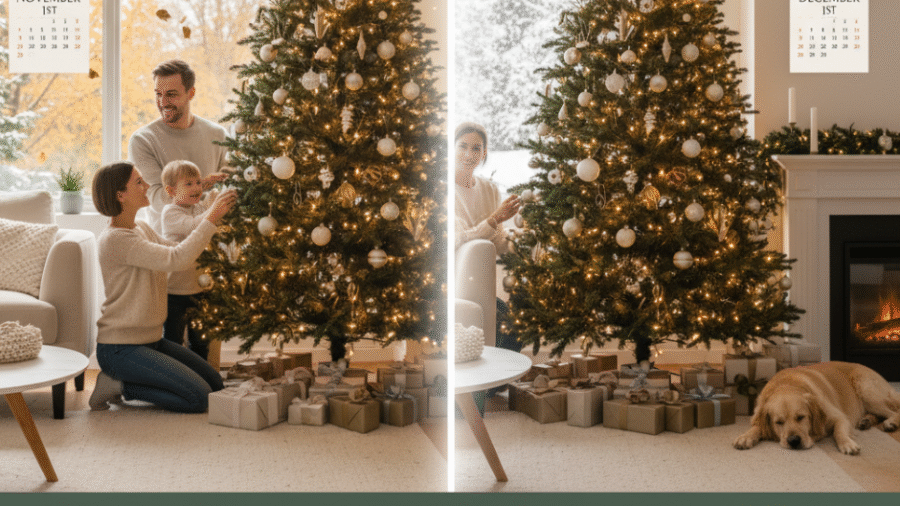One of the quintessential questions of the holiday season is when is the best time to put up a Christmas tree? While the answer can be influenced by family traditions, cultural practices, and personal preferences, there are historical, practical, and even spiritual considerations that can guide this festive decision.
This comprehensive article explores the ideal timing for setting up your Christmas tree, presents global and religious customs, offers tips on preserving your tree’s freshness, and discusses how timing can enhance your holiday celebrations.
Traditional and Cultural Perspectives on Christmas Tree Timing
The Advent Season
-
In many Christian traditions, putting up the Christmas tree coincides with the beginning of Advent, the four-week period leading up to Christmas Day, starting on the fourth Sunday before December 25.
-
This timing allows the tree to be part of the liturgical anticipation of Christ’s birth.
-
Advent trees are often unveiled during church services or family gatherings, with decorations progressively added.
December 24: Christmas Eve
-
Some families and cultures wait to set up their tree on Christmas Eve, emphasizing the arrival of Christmas Day.
-
This keeps the tree fresh throughout the Christmas Day celebrations.
-
In parts of Europe and Latin America, decorating on Christmas Eve is traditional.
Early December or Even November
-
Many people set up and decorate trees in early December or even as early as November to enjoy the festive atmosphere longer.
-
Commercial and public displays frequently begin this early, influencing home traditions.
-
The American tradition often embraces this early start as part of “the holiday season.”
Twelfth Night and Epiphany
-
Historically, some traditions hold that Christmas decorations, including trees, should remain up until January 6th (Epiphany or Twelfth Night), marking the visit of the Magi.
-
The custom to take down decorations before this date is believed to avoid bad luck.
Practical Considerations for Tree Timing
Freshness and Needle Retention
-
Real Christmas trees generally last 4 to 6 weeks indoors with proper care.
-
Setting up too early may lead to needle drop and drying before Christmas.
-
Plan according to the species of your tree and ambient indoor conditions.
Decorating Style and Family Traditions
-
Families with young children may prefer early decoration to enjoy the tree longer.
-
Others may cherish decorating as a family activity on specific dates.
-
Consider involving the household in deciding the timing for meaningful participation.
Space and Safety
-
Early setup requires ensuring safe placement away from heat sources and hazards over a sustained period.
-
Adequate watering and light management become more critical with earlier placement.
How to Keep Your Christmas Tree Fresh Longer if Put Up Early
-
Choose a tree species known for good needle retention (e.g., Fraser fir).
-
Cut a fresh slice off the base right before placing in the stand.
-
Maintain daily watering with the stand water reservoir always filled.
-
Position tree away from heaters, fireplaces, or direct sunlight.
-
Use humidifiers in dry environments to slow needle loss.
Global Variations in Christmas Tree Traditions
-
United States: Typical tree setup ranges from immediately after Thanksgiving (late November) to early December.
-
United Kingdom: Early December and Advent are common starting points.
-
Germany and Scandinavia: Some families set up the tree on December 23 or Christmas Eve.
-
Latin America: Decorating on Christmas Eve is widespread.
-
Eastern Orthodox Countries: Celebrations usually follow the Julian calendar, with Christmas trees put up closer to January 7.
Spiritual and Symbolic Timing
-
The Christmas tree, symbolizing eternal life and hope, is often timed to align with spiritual reflection during Advent.
-
Selecting the decorating day as an event of family or religious gathering enhances its meaning.
Read More: When Should You Put Up Your Christmas Tree? Timing Your Holiday Tradition Right
Conclusion
There is no single “correct” time to put up your Christmas tree—it depends on personal preference, cultural heritage, religious observance, and practical considerations. Whether you choose to embrace the long season starting in November, mark Advent’s beginning, or decorate on Christmas Eve, the most important aspect is that the timing adds joy and meaning to your holiday celebrations.
By planning according to tree freshness and family traditions while honoring cultural customs, you can ensure your Christmas tree remains a vibrant and beloved centerpiece throughout the season.



Add a Comment